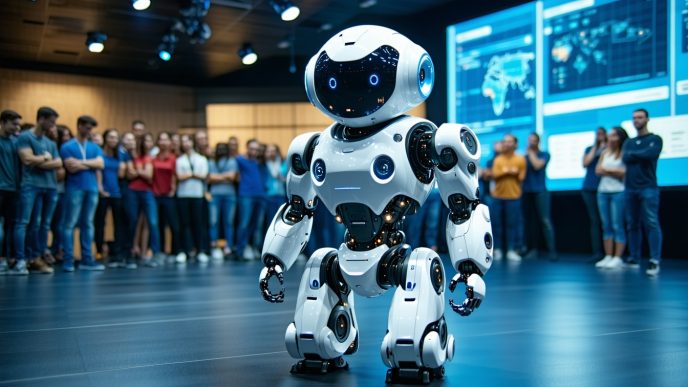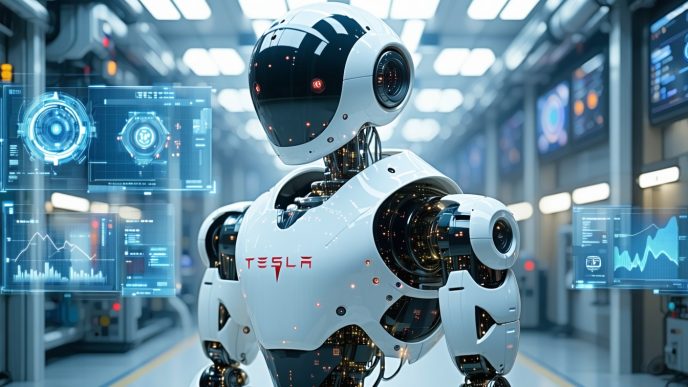Why Focus on Firmware?
Firmware is a critical aspect of robotics that often gets overlooked by consumers and enthusiasts alike. Understanding its importance can provide insights into the performance and functionality of robotic systems.
Importance of Firmware in Robotics
Firmware acts as the software backbone for robots, enabling hardware components to communicate and operate efficiently. It is a type of software that is embedded in the robotic hardware, controlling everything from basic operations to advanced functionalities. The significance of firmware in robotics can be summed up as follows:
| Feature | Description |
|---|---|
| Communication | Firmware allows different hardware components to work together seamlessly. |
| Functionality | It enables complex operations that define the robot’s capabilities. |
| Updates | Regular firmware updates can significantly enhance performance and user experience. |
The role of firmware becomes even more pivotal when considering the rapid advancements in AI technologies. AI robot firmware updates are necessary to leverage improvements in artificial intelligence, enhancing machine learning algorithms and ensuring robots can perform optimally in various environments.
Exploring the Impact of Firmware Changes
The impact of firmware changes can be profound and multifaceted. When robotics manufacturers release firmware updates, they can introduce improvements that affect performance, security, and features of the robots. Key impacts of these changes include:
| Impact Area | Description |
|---|---|
| Performance Enhancement | Firmware updates often optimize the performance of robots, increasing efficiency and response times. |
| Security Improvements | Regular updates can patch vulnerabilities, making robots more secure against potential threats. |
| New Features | Firmware updates can unlock new functionalities, keeping robotic systems competitive and relevant. |
Such adjustments can transform the usability of existing models, making them more appealing to tech-savvy consumers and early adopters who are always on the lookout for the latest innovations. Those interested in the latest advancements in robotics may want to check out our articles on robot software updates and new humanoid robots to watch.
For fans of specific robotic models, the significance of firmware is highlighted in release updates, such as the Tesla Optimus release update and Xiaomi Cyberdog 2 release, showcasing how firmware plays a crucial role in enhancing capabilities and ensuring readiness for new challenges. Keeping track of these changes not only helps in understanding the technology but also informs purchasing decisions when evaluating robot new releases.
Understanding Firmware Updates
Firmware updates play a critical role in the performance and capabilities of robotic systems. This section will clarify what firmware updates are and explain how they function.
What Are Firmware Updates?
Firmware updates are essential modifications made to the embedded software that controls a robot’s hardware. Unlike standard software applications, firmware is tightly integrated with the device’s hardware, providing the necessary instructions for its operation. These updates can range from bug fixes and performance enhancements to the introduction of new features and support for additional hardware.
Updating the firmware is crucial for ensuring that a robot operates efficiently and effectively. As technology evolves, so do the requirements for software performance, which is why manufacturers regularly release firmware updates. This keeps robots compatible with new technologies and enhances their overall capabilities.
| Type of Update | Description |
|---|---|
| Minor Updates | Small changes, often aimed at fixing bugs. |
| Major Updates | Significant changes, introducing new features and capabilities. |
| Security Updates | Patches designed to fix vulnerabilities and improve safety. |
How Firmware Updates Work
Firmware updates typically involve a series of steps that ensure a seamless transition from the old version to the new one. The process usually includes the following:
-
Release Announcement: Manufacturers announce the availability of the firmware update along with details regarding new features and improvements. Interested users can refer to resources on robot new releases for the latest information.
-
Download: Users can download the update via the robot’s system interface or a connected application. Ensuring a stable internet connection during this phase is crucial.
-
Installation: The new firmware is installed onto the device, usually requiring a restart. This phase may involve prompts to confirm the update and ensure compatibility with existing hardware.
-
Verification: After installation, the robot may run self-tests to verify that the firmware has been installed correctly and is functioning as intended.
-
Support: If issues occur during or after the update, users can refer to customer support or online resources, including information on robot software updates.
| Step | Description |
|---|---|
| Step 1 | Release announcement and information sharing. |
| Step 2 | Downloading the firmware update. |
| Step 3 | Installing the update on the robot. |
| Step 4 | Verifying successful installation. |
| Step 5 | Providing support for any issues. |
Understanding how firmware updates work is essential for tech-savvy consumers and robotics enthusiasts. These updates can significantly influence the functionality and performance of robots, ultimately enhancing their capabilities. For further insights, one can check out upcoming releases, such as the Xiaomi Cyberdog 2 release or the Apptronik Apollo debut.
The Significance of AI in Robotics
Role of AI in Robotics
Artificial Intelligence (AI) plays a vital role in the evolution of robotics. It enhances the capabilities of robots, enabling them to perform complex tasks that require learning, decision-making, and adaptability. AI algorithms allow robots to analyze data from their environment, recognize patterns, and make informed choices based on that information. This integration transforms standard robots into intelligent systems capable of dynamic interactions and improved performance.
Key functions of AI in robotics include:
| Function | Description |
|---|---|
| Navigation | AI enables robots to navigate through various environments efficiently, avoiding obstacles and optimizing routes. |
| Object Recognition | Robots can identify and categorize objects using AI, enhancing their ability to interact with humans and environments. |
| Learning | AI allows robots to learn from experience, improving their functionality over time and adapting to new tasks. |
Fusion of AI and Firmware Updates
The combination of AI and firmware updates presents exciting opportunities for advancements in robotics. As robots evolve, their firmware needs to be updated to support new AI algorithms and functionalities. These firmware changes can introduce improved features, optimized performance, and enhanced security protocols.
AI robot firmware updates can include:
| Update Type | Benefits |
|---|---|
| Performance Enhancements | Updates can improve processing speed and efficiency, allowing robots to handle tasks more effectively. |
| Feature Additions | New functionalities, such as enhanced navigation or better object recognition, can be added through firmware updates. |
| Security Improvements | Regular firmware updates can fortify security measures, protecting robots from vulnerabilities and ensuring safe operation. |
Staying informed about these updates is essential for tech-savvy consumers and robotics enthusiasts who want to leverage the latest technological advancements. For more insights into the latest developments, readers can refer to articles on robot new releases and robot software updates. Keeping track of innovations ensures they remain at the forefront of robotics technology, enhancing their understanding as new models and features are introduced.
Advantages of Firmware Updates
Firmware updates play a crucial role in the performance and capabilities of robotic systems. By implementing these updates, manufacturers can significantly enhance functionality, bolster security, and introduce new features, all of which contribute to a better user experience.
Enhancing Performance
Performance improvements are often at the forefront of firmware updates. These updates can optimize the algorithms that govern a robot’s operational tasks, resulting in faster processing times and more efficient performance.
| Feature | Impact Before Update | Impact After Update |
|---|---|---|
| Processing Speed | Moderate | High |
| Task Completion Time | Variable | Reduced |
| Efficiency | 75% | 90% |
Regular performance enhancements ensure robots can handle more complex tasks and operate seamlessly in dynamic environments. For the latest improvements in robot functionality, check out relevant articles on robot software updates.
Improving Security
Enhanced security is another vital advantage of firmware updates. As with any technology, robotics systems are susceptible to vulnerabilities. Regular updates help patch security loopholes, preventing potential unauthorized access or malicious attacks.
| Security Measure | Status Before Update | Status After Update |
|---|---|---|
| Vulnerabilities Detected | 5 | 0 |
| Response Time to Threats | 30 minutes | 5 minutes |
| User Data Protection Level | Moderate | High |
By keeping a robot’s firmware current, users can ensure that their devices are equipped with the latest security protocols, significantly reducing risks. For details on evolving security features, refer to updates on robot new releases.
Introducing New Features
Firmware updates often come with the introduction of new features that enhance the utility of robots. These features can range from improved sensory capabilities to new software functionalities that allow for greater control over robotic systems.
| Feature Type | Features Before Update | Features After Update |
|---|---|---|
| Sensor Range | 20 meters | 50 meters |
| Control Options | Basic | Advanced |
| Functionality | Fixed Tasks | Customizable Tasks |
These enhancements not only enrich the user experience but also foster greater innovation in robotics. To stay informed on the newest functionalities and offerings, explore articles such as the tesla optimus release update or the unitree g1 release news.
The benefits of firmware updates extend beyond immediate enhancements, playing a key role in the overall evolution of robotic technology.
Challenges of Firmware Changes
Navigating firmware changes in robotics can present several challenges that need to be addressed for successful implementation. These obstacles range from compatibility issues to risks associated with the update process.
Compatibility Issues
A significant challenge when it comes to firmware updates is ensuring compatibility with existing hardware and software. As robotics technology evolves, older firmware may struggle to interface with new components or systems. This can lead to functionality issues or reduced performance.
| Compatibility Factor | Impact |
|---|---|
| Hardware Alignment | Mismatched parts may not work together, leading to device malfunctions. |
| Software Interoperability | Applications relying on older firmware might not function properly with new updates. |
| Version Limitations | Some devices may be restricted to certain firmware versions, limiting future updates. |
To avoid these issues, developers must thoroughly test new firmware with a range of hardware configurations before deployment.
Risks of Updating Firmware
Updating firmware carries inherent risks that can impact device reliability and user experience. A failed update can render a robot inoperable, resulting in downtime and potential data loss. Furthermore, bugs introduced during the update process can lead to unexpected behavior that affects the robot’s performance.
| Risk Factor | Potential Consequences |
|---|---|
| Failed Updates | Devices may require factory resets or repairs to restore functionality. |
| Bugs and Glitches | New features could malfunction, affecting user trust and satisfaction. |
| Security Vulnerabilities | Weaknesses may be introduced that expose the system to cyber threats. |
Mitigating these risks involves implementing robust testing and validation processes prior to release.
Ensuring a Smooth Update Process
A smooth update process is essential for minimizing disruptions to users and ensuring the functionality of robotics systems. Key factors include creating user-friendly interfaces and providing clear instructions for performing updates. Offering support and troubleshooting options can also enhance the update experience.
| Smooth Process Indicator | Description |
|---|---|
| User Feedback | Collecting feedback helps identify pain points in the update process. |
| Transparent Communication | Keeping users informed about the update and its benefits builds trust. |
| Support Availability | Providing readily available assistance can resolve issues quickly. |
By focusing on these aspects, developers can enhance the experience surrounding their robot software updates, ultimately leading to improved performance and user satisfaction. For more insights on the latest robotics innovations, explore our robot new releases section.
Future of Firmware Updates in Robotics
As technology continues to advance, the future of firmware updates in robotics is poised for significant transformation. The integration of AI, enhancements in connectivity, and evolving user needs will shape how robots operate and improve over time.
Evolving Technologies
The landscape of robotics is constantly changing, driven by evolving technologies. One major area of advancement is the integration of AI capabilities within robots, leading to more intelligent and adaptive systems. This infusion of AI will enhance the ability of robots to learn from their environments and optimize their performance through continuous firmware updates.
Additionally, advancements in communication technologies, such as 5G, will enable faster and more reliable firmware updates. This increased connectivity allows robots to receive timely updates, ensuring they operate with the latest features and security patches. As these technologies evolve, firmware updates will become a seamless part of robotic functionality.
| Technology | Impact on Firmware Updates |
|---|---|
| AI Integration | Enhanced learning and performance optimization |
| 5G Connectivity | Faster and more reliable updates |
| Cloud Computing | Centralized storage for easy update management |
Potential Innovations
The potential for innovations in firmware updates is immense. Future updates may include enhanced machine learning algorithms that enable robots to adapt to user preferences and working conditions effectively. This will create a more personalized user experience and increase the efficiency of robotic applications.
Furthermore, integration with Internet of Things (IoT) devices will allow for real-time data sharing. Robots could receive firmware updates based on aggregated data from various sensors and devices, facilitating more informed decision-making. These innovations will ensure that firmware updates are not just routine maintenance but an opportunity for significant enhancements.
Embracing Continuous Improvement and Adaptation
As robotics technology evolves, the concept of continuous improvement will become essential. The push for robot software updates will evolve into a culture of iterative enhancements. Companies will prioritize gathering user feedback on firmware performance, ensuring that updates are tailored to meet the needs of their users.
This mindset will also foster a community of developers and users who collaboratively contribute to firmware improvements. As more consumers embrace robotics in their daily lives, the demand for effective and agile firmware systems will only grow, making it imperative for manufacturers to remain adaptive.
The journey of robotics will unfold with exciting developments. Keeping an eye on robot new releases and expecting regular updates will be key for tech-savvy consumers and robotics enthusiasts alike as they navigate this rapidly changing field.














